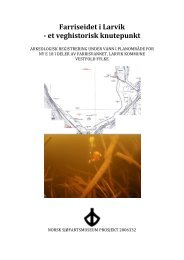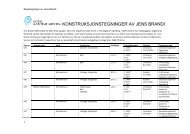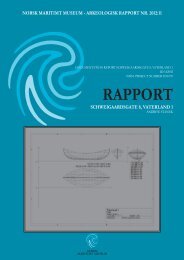Last ned 2009230_Rapport_Sørenga9_liten.pdf - Norsk Maritimt ...
Last ned 2009230_Rapport_Sørenga9_liten.pdf - Norsk Maritimt ...
Last ned 2009230_Rapport_Sørenga9_liten.pdf - Norsk Maritimt ...
Create successful ePaper yourself
Turn your PDF publications into a flip-book with our unique Google optimized e-Paper software.
The results can be summarised according to the structure of the samples, as textiles, caulking<br />
cords and pads of felted fibre.<br />
Textiles<br />
Tarred textiles had been used in Sørenga 8 X030, X031 and Sørenga 9 X019, X020 and X022,<br />
mostly as cut and torn strips. In 8X030 two large fragments of different textiles had been folded<br />
and placed behind a strake; in 8X031 a smaller fragment was recovered from the keel; in 9X019,<br />
a rectangular piece appears to have been nailed in place; in 9X020 and 9X022, fragments of<br />
different textiles had been packed under repair patches and nailed or riveted.<br />
All proved to be fragments of medium-coarse 2/1 twill, with Z-spun yarn in one direction and Sspun<br />
yarn in the other. The wale of the twill weave runs in the Z-direction (NE-SW when the<br />
textile is held with the Z-spun system running vertically and the Z-face facing towards the<br />
viewer). The textiles are made from naturally pigmented fleeces (brown, grey or black), often<br />
darker in the Z-spun system than the S-spun, which is a common feature of Nordic products<br />
(Walton Rogers 2004). They closely resemble the textiles from Vaterland I and Sørenga 7 (Table<br />
1) and are likely to represent medium-to-low-grade Norwegian products. Example 8X030a has at<br />
least one weaving gore and 9X019 has remains of a possible starting border, both of which are<br />
features associated with the warp-weighted loom of Norway and Iceland (Hoffmann 1974, 181;<br />
Walton Rogers in prep [Reykholt report]).<br />
Caulking cords<br />
Loosely spun and plied cords were identified in Sørenga 8 X034, X046, X055, Sørenga 9 X032 and<br />
Sørenga båtflak X008. They were all two-ply, S-twisted from Z-twist single strands (Z2S), the<br />
angle of the ply being 20°-30° from vertical. In their flatte<strong>ned</strong> state the Sørenga 8 and 9<br />
specimens were 20-25 mm x 6-10 mm, which probably represents a diameter of about 15-20<br />
mm, but the båtflak example was thinner and more irregular, at 10-18 mm x 4 mm (probably<br />
about 8-12 mm diameter). The fibres in the Sørenga 8 cords were calf (young cattle), in Sørenga<br />
9 goat and in båtflak X008 sheep’s wool.<br />
Evidence from Britain and Norway has shown that medieval caulking materials were almost<br />
exclusively made of animal fibres until the early 16th century, when plant fibres started to<br />
emerge, in parallel with the rise of carvel (skeleton first) construction (Walton Rogers and Hall<br />
2009; ASLab rep 3 July 2011.) At the same time, the caulking cords from Bergen have<br />
demonstrated a shift in emphasis from multi-ply wool cords to two-ply hair cords, with single<br />
non-plied strands representing a relatively small additional group (Schjølberg 1984, 75-7). In<br />
addition there was a tendency for the use of thicker cords from the mid 13th century onwards in<br />
the Bergen material (ibid. 77). At Oslo, in the Sørenga 8 and 9 boats, the thick two-ply goat and<br />
calf-hair cords fit the dendrochronology dates which place them in the late 15th century. In<br />
contrast, the undated båtflak caulking would fit most naturally in the 12th- and early 13thcentury<br />
collection from Bergen. Since, however, a small number of wool caulking cords still<br />
continued to be used in later centuries, it would be risky to date the båtflak timbers from the<br />
caulkage alone.<br />
2








